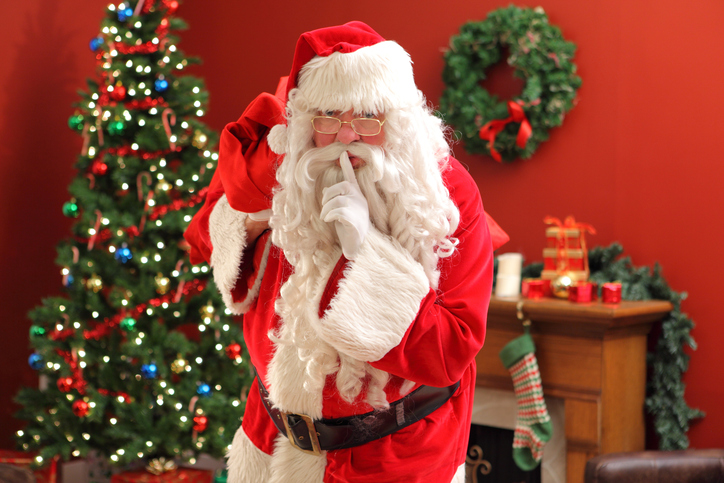Who is the real Santa Claus? And should he be part of your family’s holiday tradition?
There’s plenty of debate over whether or not to tell kids the truth about Santa. Which is the topic of a related article, oh the dreaded question…is Santa Claus real?
While pondering whether or not the Santa Claus myth makes sense today, our thoughts turned to the origin of Santa Claus.
Seriously, where in the heck did a story about a bearded guy flying around in a sleigh come from in the first place?
As you can imagine, there are lots of guesses.
He’s St. Nicholas, right? Or Father Christmas? Or was it Kris Kringle?
Wait… didn’t Coca Cola invent the red costumed Santa to sell soda?
At this point, we realized we had no idea where Santa Claus originated.
So we decided to do some research, and let me tell you… the Santa story is fascinating!
The guy we know as Santa is a mash-up of religion, politics, culture, and tradition with a dash of commercialism thrown in for good measure.
Who is the real Santa Claus? Inquiring minds want to know!
Join us on a little sleuthing mission, where we get to the bottom of where the modern-day Santa really came from. It might help you decide what you want to tell your kids.

Who Is The Real Santa Claus?
The History Of St. Nicholas
First off, know that the Santa legend is a tricky web of myth, religion, and culture that stretches back thousands of years. Most countries have their own version of the gift-giving jolly guy, and we can’t possibly dive into all of them.
So we’re focusing on the historical thread that leads to the chubby, spectacled guy in the red fur coat saying “ho,ho, ho” at your local mall.
Almost all the stories trace their origins back to St. Nicholas, a monk born around A.D. 280 who lived in the country known today as Turkey. He was a very wealthy man known for his kindness and generosity.
St. Nicholas had a reputation for helping the poor and giving secret gifts to people who needed them.
For these reasons, St. Nick was an extremely popular saint.
In newly christianized areas of Europe, where pagan cults still remained, legends of the god Woden were blended together with those of well-known saints, like St. Nicholas.
By absorbing pagan traditions, the Christian Church could subtly bring their own ideas to the people; such as a good St. Nicholas bringing gifts, while grudgingly allowing some of the old god myths to remain.
In parts of Europe, St. Nick was accompanied by the pagan Dark Helper, a chained slave inherited from the Woden tradition who carried the saint’s bag.
While St. Nick brought gifts to those who were “good”, the Dark Helper scared children who were not devout, and would throw sinners into his bag and carry them to the “bad place”.
So basically kids better get onboard with the new religion or get taken to Hell by the dark helper.
A New World Mash-Up
After the reformation of the 17th century, all the saints were basically thrown out. The feast of St. Nicholas was abolished in many parts of Europe, including England.
They had to replace him with something less “saintly”. So Father Christmas was brought in as a substitute.
The Dutch, however, were still fans of St. Nicholas, who they called “Sinter Klaas”.
They had their own traditions around Sinter Klaas bringing gifts to good children in either a stocking or shoe.
Around this time both Dutch and English settlers arrived in New York and brought Sinter Klaas and Father Christmas along for the ride.
The two traditions got mushed together into a gift-giving fatherly Klaas (or Claus) character, with some old-world traces of punishment for “bad” behavior thrown into the mix.
The Santa Claus story was coming together.

Santa Gets A Commercial Makeover
In 1823, Clement Moore published a poem popularly known as “The Night Before Christmas”. Although many people now believe he actually stole the poem from a relative, Henry Livingston Jr.
Whoever it was that wrote the poem described Santa Claus as a “right jolly old elf” with a belly and a sleigh pulled by reindeer.
This is when Santa starts to be depicted as chubby and hanging out with Donner and Blitzen!
Many people think Coca Cola designed the familiar white-trimmed red suit we associate with Santa today, but this is an urban legend.
An illustrator named Thomas Nast published a series of drawings In Harper’s Weekly beginning in the late 1800s.
He is credited with developing the initial image of a bearded man with a pipe and red suit to represent Santa.
Then in 1931, the coca-cola company decided it wanted to increase sales of soda to kids. (The law at the time didn’t allow them to show children actually drinking soda.)
So the marketing guys thought, hmmm… how about if we show kids handing a coke to a friendly, more commercial looking Santa instead?
The artist Haddon Sunbloom created the iconic image of a bright-red costumed Santa with a coke in hand that translates into all the mall Santas you see today!
So basically, if you want to know “who is the real Santa Claus?” The guy coming down your chimney was loosely based off a generous, gift-giving saint.
Santa’s naughty list is a throwback to the enslaved pagan Dark Helper and his punishment for bad kids that didn’t follow the program.
The jolly attitude and flying sleigh are from a poem that was likely stolen.
And the bright red suit, rosy cheeks and big smile we are familiar with came from Coca-Cola trying to sell more soda to kids.
And that’s a very simplified version of the Santa Claus story! Wrap your head around that for a minute.
Is this guy someone you want your kids to believe is real? Or maybe he could be more of a fun seasonal character, rather than a real guy.
Now that you know the origin story behind who is the real Santa Claus, you can decide how and when to include him in your holiday celebrations.
Also In Beenke: Oh The Dreaded Question… “Is Santa Claus Real?”
SHARE The wild story of “who is the real Santa Claus?” on Facebook or Pinterest by clicking the buttons below.












